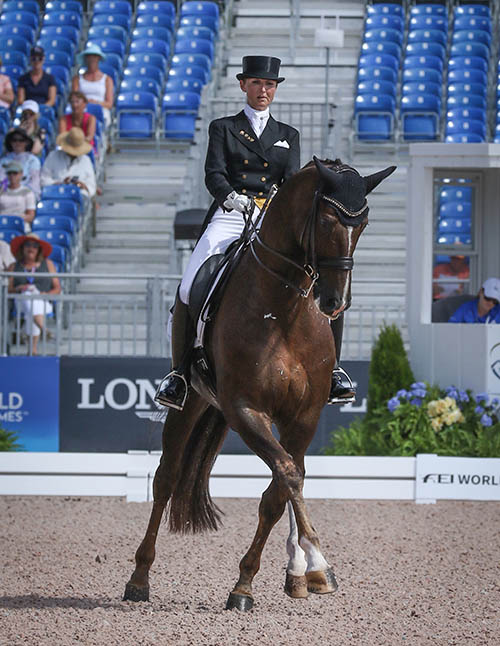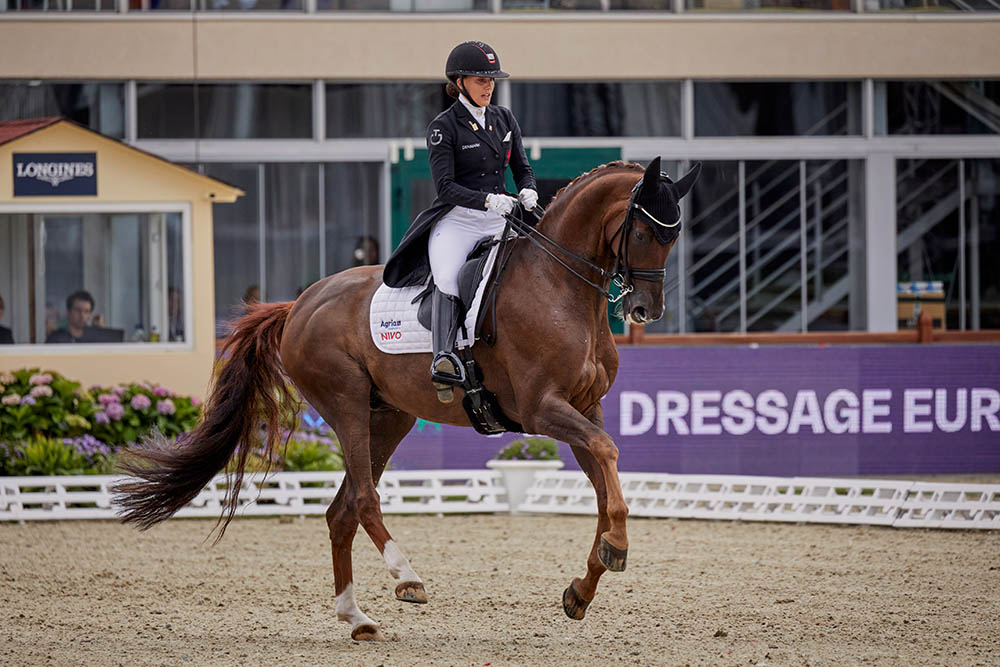Do you understand the meaning of the term ‘straightness’? Starting with the definition from our reference book, The Principles of Riding, let’s explore this important concept.

The Principles of Riding defines straightness as follows: “A horse is said to be straight when its forehand is in line with its hindquarters, that is, when the longitudinal axis is in line with the straight or curved track it is following. In Germany, the horse is then also said to be ‘covering the track’. Straightness is necessary in order for the weight to be evenly distributed over the two halves of the body. It is developed through systematically training and suppling (gymnasticising) both sides of the body equally.
“Most horses are naturally crooked like right-handed and left-handed humans. This crookedness has its origins in the brain and is something the horse is born with. Also, the horse’s shoulders are narrower than its hindquarters, which further encourages it to be crooked.
“In most cases, the right-hand hind foot is set down further to the right than the right forefoot. As a result, the right hind leg has to push forward more while the left hind leg is required to bend more. Also, the left foreleg is subjected to more wear and tear.
“If more weight is transferred onto the hindquarters so that the hind legs are required to bend more, the left hind leg will be able to bend and the right leg will try to avoid doing so by stepping sideways, outside the track of the right forefoot.
“Straightness is necessary for the following reasons:
- So that the horse’s weight is evenly distributed on both sides and to avoid excessive wear and tear on the limbs on one side.
- So that the horse can push equally and effectively with its hind legs to (optimise the forward thrust).
- So that the rider can keep the horse on the aids properly and develop its suppleness (durchlassigkeit).
- To enable the horse to have an even contact on both sides.
- In order to obtain collection.
“Only if the horse is straight can it be equally supple and through on both reins.
“NOTE: If the horse is straight, the hind legs will push exactly in the direction of the centre of gravity. The restraining aids will then also pass through the horse correctly, via the mouth, poll, neck and back to the hindquarters, and they will act on both hind legs equally.
“Straightening the horse is a never-ending task, since every horse has some degree of natural crookedness. Straightness is a precondition for collection, because only if the horse is straight can the weight be transferred onto both hind legs equally.”
There you have it! Over 400 words carefully used to explain one word – one element of the Training Scale – ‘Straightness’.
NATURAL CROOKEDNESS
To understand straightness better, let’s first think more about the horse’s natural crookedness. After all, if we’re going to make our horses straighter, we need to understand the problem we’re up against. If you think about the above description of the naturally crooked horse, you can also see how that equates to a “stiff” side and a “hollow” side in your horse. Your horse is going to have a stiff side, usually the left side – and a hollow side, normally the right side. Occasionally this can be vice versa, but for the purpose of an example in this article, let’s stick to the typical stiff to the left, hollow to the right.
At clinics, I often ask the riders if they have any specific problems they would like to work on in the session. I would say the No. 1 thing people mention is that their horse is stiff to the left! The same riders are often happy with the way the horse will bend to the right and be light in their right hand. So, here’s a little exercise that you can do at home to try to feel the natural crookedness of the horse. The exercise is to simply ride a 20-metre circle on the left and then on the right rein. If in trying to create the correct bend and flexion for the circle to the left you find your circle has a tendency to become smaller, and then to the right your horse happily bends and flexes but your circle has a tendency to grow larger, you are feeling something that’s normal. Horses are not the same left and right. It’s important to accept this and not think of it as unusual or specific to you and your horse.
If we look again at the description of the crooked horse in our definition above, it says the right hind leg lands to the right side of the right foreleg. Another way to think about what’s going on here is to imagine the horse likes to have his shoulders to the left. If his shoulders are left, you can see that the right hind leg would land to the right side of the right foreleg. The right hind leg does not like to travel under the horse’s centre of balance. The joints of the right hind leg are reluctant to bend, and he avoids taking weight with that leg.
So, to make the horse straight, one of the first things we must understand is that the right side is actually crooked. The horse finds it easy to bend on the right side because his shoulders are pushing left. His hind legs are not pushing forward towards his centre of gravity. This is why it’s described as the “hollow” side.
There are plenty of other examples of how crookedness shows up in different movements. In shoulder-in to the left, there is often not enough bend through the horse’s body but plenty of angle. To the right there is often too much bend through the neck and too little angle through the body.

In half-pass left, we often have too little bend, but the horse is happy to move laterally. To the right, there’s plenty of bend, but reluctance to move laterally. Especially the shoulders. The right canter can be slower in the tempo than the left. Here is a link to a beautiful horse doing a half-pass in canter to the right and then the left. This is very good half-pass in both directions. Look at the tempo, the amount of bend and the ease in which the horse moves laterally. In observing the video, is there any difference in the horse between the left and the right side?
Straightness continues to be a focus for every trainer, from Preliminary to Grand Prix. Each movement in a dressage test is performed on both reins so the judge has the opportunity to see the symmetry and assess the horse’s straightness. Suppling and strengthening the horse in the quest for symmetry and straightness never ends.
Flying changes from right to the left side are often easier. Changing from the left to the right side is the difficult side and you are more likely to see a late change. Thinking about the crooked horse, can you see how riding a flying change out of half-pass left may help to encourage a clean change to the right?

“You can’t hold
straightness on your
hand or your leg.”
When you ride your own horse, try to feel what’s going on through his body. Remember, what you feel in your hand is not a problem in his mouth. What we feel in the contact is a reflection of the way our horse is working. When you feel the unevenness of a crooked horse in the contact, think of how you might change his way of going as a whole, to encourage him to be more even in your hand. The rhythm you ride him in is a great place to start. Using the correct words shows you have a true understanding of the German training system. Try to avoid referring to the horse’s mouth.
Keeping the horse forward and straight is not an easy thing to do. The “note” in the definition above from The Principles of Riding that explains “the horse’s hind legs should always push forwards exactly towards his centre of gravity” is a complex idea to understand. This also means that if the rider, to turn the horse, pulls against the horse’s direction of travel, it is crooked. My favourite analogy to understand this is to think of how it would feel to turn on a pogo stick. If you pull the top of the stick (pull the rein) in the direction you want to go, you lose balance and fall off! To turn, you have to bring the centre of balance with you through the turn. You are directing your horse’s forward thrust, so his centre of balance is always under you.
A little test you might like to try is to imagine someone cuts your reins with scissors as you ride a circle. Would your horse suddenly fall in or out? Imagine the same thing happens as you travel down the centreline. You can’t hold straightness on your hand or your leg. A horse that is straight should be in self-carriage. He seeks the contact in free forward movement. Aids that try and hold straightness inevitability cause tension and impede free forward movement. Remember in the definition that a straight horse becomes more even in the contact.
As you can see, every exercise from riding 20m circles to the half-pass and flying changes are affected by straightness. This article is more about being aware of straightness, so that whatever exercise you ride, you are conscious of it. Having a true understanding of straightness will influence the way you ride every step your horse takes.
Thanks for taking the time to read my articles and I hope they help some riders out there. Next, I think we’ll expand our vocabulary with the word “Collection”. EQ
YOU MIGHT ALSO LIKE TO READ:
The Language of Dressage: Rhythm – Equestrian Life, May 2022

